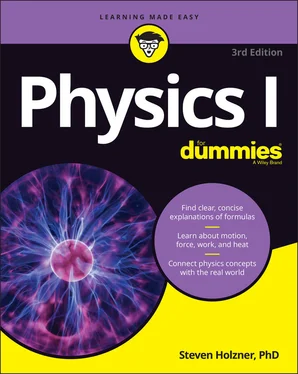Like speed, acceleration takes many forms that affect your calculations in various physics situations. In different physics problems, you have to take into account the direction of the acceleration (whether the acceleration is positive or negative in a particular direction), whether it’s average or instantaneous, and whether it’s uniform or nonuniform. This section tells you more about acceleration and explores its various forms.
 In physics terms, acceleration, a , is the amount by which your velocity changes in a given amount of time, or
In physics terms, acceleration, a , is the amount by which your velocity changes in a given amount of time, or

Given the initial and final velocities, v i and v f , and the initial and final times over which your speed changes, t i and t f , you can also write the equation like this:

Acceleration, like velocity, is actually a vector and is often written as a,in vector style (see Chapter 4). In other words, acceleration, like velocity but unlike speed, has a direction associated with it.
Determining the units of acceleration
You can calculate the units of acceleration easily enough by dividing velocity by time to get acceleration:

In terms of units, the equation looks like this:

Distance per time squared? Don’t let that throw you. You end up with time squared in the denominator because you divide velocity by time. In other words, acceleration is the rate at which your velocity changes, because rates have time in the denominator. For acceleration, you see units of meters per second 2, centimeters per second 2, miles per second 2, feet per second 2, or even kilometers per hour 2.
 It may be easier, for a given problem, to use units such as mph/s (miles per hour per second). This would be useful if the velocity in question had a magnitude of something like several miles per hour that changed typically over a number of seconds.
It may be easier, for a given problem, to use units such as mph/s (miles per hour per second). This would be useful if the velocity in question had a magnitude of something like several miles per hour that changed typically over a number of seconds.
Looking at positive and negative acceleration
Just as for displacement and velocity, acceleration can be positive or negative. This section explains how positive and negative acceleration relate to changes in speed and direction.
The sign of the acceleration tells you whether you’re speeding up or slowing down (depending on which direction you’re traveling).
For example, say that you’re driving at 75 miles per hour, and you see those flashing red lights in the rearview mirror. You pull over, taking 20 seconds to come to a stop. The officer appears by your window and says, “You were going 75 miles per hour in a 30-mile-per-hour zone.” What can you say in reply?
You can calculate your rate of acceleration as you pulled over, which, no doubt, would impress the officer — look at you and your law-abiding tendencies! You whip out your calculator and begin entering your data. Remember that the acceleration is given in terms of the change in velocity divided by the change in time:

Plugging in the numbers, your calculations look like this:

Your acceleration was 3.8 mph/s. But that can’t be right! You may already see the problem here; take a look at the original definition of acceleration:

Your final speed was 0 mph, and your original speed was 75 mph, so plugging in the numbers here gives you this acceleration:

In other words, –3.8 mph/s, not +3.8 mph/s — a big difference in terms of solving physics problems (and in terms of law enforcement). If you accelerated at +3.8 mph/s rather than –3.8 mph/s, you’d end up going 150 mph at the end of 20 seconds, not 0 mph. And that probably wouldn’t make the cop very happy.
Now you have your acceleration. You can turn off your calculator and smile, saying, “Maybe I was going a little fast, officer, but I’m very law-abiding. Why, when I heard your siren, I accelerated at –3.8 mph/s just in order to pull over promptly.” The policeman pulls out his calculator and does some quick calculations. “Not bad,” he says, impressed. And you know you’re off the hook.
 The sign of the acceleration depends on direction. If you slow down to a complete stop in a car, for example, and your original velocity was positive and your final velocity was 0, then your acceleration is negative because a positive velocity came down to 0. However, if you slow down to a complete stop in a car and your original velocity was negative and your final velocity was 0, then your acceleration would be positive because a negative velocity increased to 0.
The sign of the acceleration depends on direction. If you slow down to a complete stop in a car, for example, and your original velocity was positive and your final velocity was 0, then your acceleration is negative because a positive velocity came down to 0. However, if you slow down to a complete stop in a car and your original velocity was negative and your final velocity was 0, then your acceleration would be positive because a negative velocity increased to 0.
Looking at positive and negative acceleration
When you hear that acceleration is going on in an everyday setting, you typically think that means the speed is increasing. However, in physics, that isn’t always the case. An acceleration can cause speed to increase, decrease, and even stay the same!
Acceleration tells you the rate at which the velocity is changing. Because the velocity is a vector, you have to consider the changes to its magnitude and direction. The acceleration can change the magnitude and/or the direction of the velocity. Speed is only the magnitude of the velocity.
Here’s a simple example that shows how a simple constant acceleration can cause the speed to increase and decrease in the course of an object’s motion. Say you take a ball, throw it straight up in the air, and then catch it again. If you throw the ball upward with a speed of 9.8 m/s, the velocity has a magnitude of 9.8 m/s in the upward direction. Now the ball is under the influence of gravity, which, on the surface of the Earth, causes all free-falling objects to undergo a vertical acceleration of –9.8 m/s 2. This acceleration is negative because its direction is vertically downward.
With this acceleration, what’s the velocity of the ball after 1.0 second? Well, you know that

Rearrange this equation and plug in the numbers, and you find that the final velocity after 1.0 second is 0 meters/second:
Читать дальше

 In physics terms, acceleration, a , is the amount by which your velocity changes in a given amount of time, or
In physics terms, acceleration, a , is the amount by which your velocity changes in a given amount of time, or



 It may be easier, for a given problem, to use units such as mph/s (miles per hour per second). This would be useful if the velocity in question had a magnitude of something like several miles per hour that changed typically over a number of seconds.
It may be easier, for a given problem, to use units such as mph/s (miles per hour per second). This would be useful if the velocity in question had a magnitude of something like several miles per hour that changed typically over a number of seconds.















